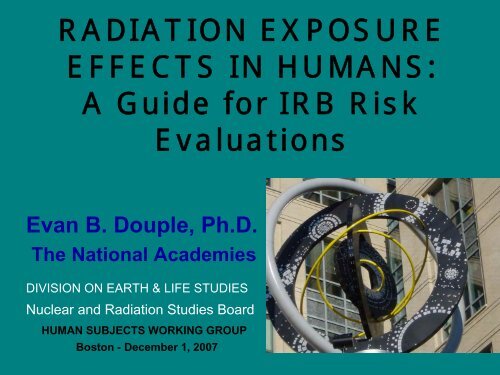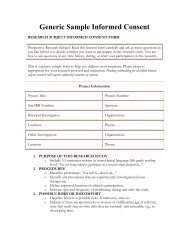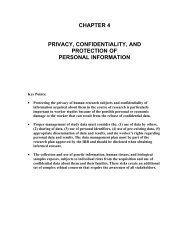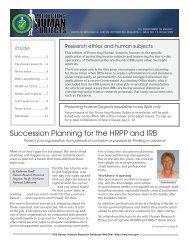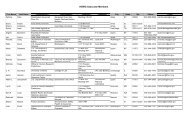Radiation Exposure Effects in Humans - Department of Energy ...
Radiation Exposure Effects in Humans - Department of Energy ...
Radiation Exposure Effects in Humans - Department of Energy ...
Create successful ePaper yourself
Turn your PDF publications into a flip-book with our unique Google optimized e-Paper software.
RADIATION EXPOSURE<br />
EFFECTS IN HUMANS:<br />
A Guide for IRB Risk<br />
Evaluations<br />
Evan B. Douple, Ph.D.<br />
The National Academies<br />
DIVISION ON EARTH & LIFE STUDIES<br />
Nuclear and <strong>Radiation</strong> Studies Board<br />
HUMAN SUBJECTS WORKING GROUP<br />
Boston - December 1, 2007<br />
1
KEY QUESTIONS<br />
• What do we know about bio effects <strong>of</strong><br />
exposure to ioniz<strong>in</strong>g radiation?<br />
• What evidence is there for certa<strong>in</strong> health<br />
effects <strong>in</strong> humans?<br />
• What is the estimate <strong>of</strong> risk for adverse health<br />
effects <strong>in</strong> humans?<br />
• What levels <strong>of</strong> radiation exposure are<br />
humans exposed to <strong>in</strong> medical procedures?<br />
• What is the relevance <strong>of</strong> the potential health<br />
risks to the human subject and the IRB?<br />
2
OUTLINE<br />
• Review <strong>of</strong> Radiobiological Mechanisms<br />
– Indirect action<br />
– Direct Action<br />
• Determ<strong>in</strong>istic <strong>Effects</strong><br />
– Cutaneous<br />
– Ocular (cataracts)<br />
– Gonadal (sterility)<br />
– Chronic radiation disease<br />
– Consequences <strong>of</strong> In Utero <strong>Exposure</strong>s<br />
• Stochastic <strong>Effects</strong><br />
– Genetic effects (mutations)<br />
– Cancer<br />
• Analyses <strong>of</strong> <strong>Effects</strong> <strong>in</strong> Human Populations<br />
– <strong>Radiation</strong> <strong>Effects</strong> Research Foundation (RERF)<br />
– BEIR VII<br />
– Quantify<strong>in</strong>g <strong>Radiation</strong> Risk<br />
• Doses from Diagnostic Medical <strong>Exposure</strong>s<br />
• Summary (What does this mean to the patient and IRB?)<br />
3
STATE OF KNOWLEDGE<br />
• <strong>Effects</strong> <strong>of</strong> ioniz<strong>in</strong>g radiation are well-known<br />
(especially compared to most toxic agents)<br />
• Mechanisms are proposd or identified, albiet<br />
with some miss<strong>in</strong>g gaps<br />
• A dose-effect response curve is known with<br />
measured and reasonable certa<strong>in</strong>ty at<br />
moderate doses and high doses, but must be<br />
modeled at low doses<br />
• Data exists <strong>in</strong> humans for most effects<br />
4
RADIOBIOLOGICAL MECHANISMS<br />
Textbook <strong>of</strong> Military Medic<strong>in</strong>e, Part 1 Volume 2, 1989<br />
5
MECHANISMS<br />
• Radiolytic chemistry<br />
(e - , H 2 O + , e - aq,H*, OH* free radicals)<br />
vs endogenous oxidative products<br />
• DNA damage<br />
(SSB, DSB, LMDS, damaged bases)<br />
• Deletions and chromosome aberrations<br />
• Mutations transformation/cancer<br />
• Mitotic <strong>in</strong>hibition/cell death or apoptosis<br />
6
BEIR VII FIG 1-8: Illustration <strong>of</strong><br />
primary and secondary electron<br />
tracks produc<strong>in</strong>g clusters (see<br />
arrow) <strong>of</strong> ionization events.<br />
Panel A: the calculated number <strong>of</strong><br />
tracks is based on a nucleus with<br />
a diameter <strong>of</strong> 8 mm. The track<br />
size is enlarged relative to the<br />
nucleus to illustrate the theoretical<br />
track structure. Panel B: the arrow<br />
identifies an ionization cluster near<br />
a DNA molecule to represent the<br />
possibility <strong>of</strong> locally multiply<br />
damaged sites. Only a segment<br />
<strong>of</strong> an electron track is illustrated <strong>in</strong><br />
Panel B.<br />
7
BIOMARKERS OF LOW DOSE<br />
DNA DAMAGE & REPAIR<br />
γH2AX: a m<strong>in</strong>or histone (1-2% total H2A)<br />
• Phosphorylated on ser<strong>in</strong>e-139 under “stress”<br />
• A marker <strong>of</strong> changes <strong>in</strong> chromat<strong>in</strong> conformation<br />
from DNA double strand breakage, excision repair<br />
and DNA replication<br />
• H2AX -/- mice are genomically unstable & cancer<br />
prone<br />
8
Formation and repair <strong>of</strong> γH2AX foci <strong>in</strong><br />
normal human cells at very low doses <strong>of</strong><br />
ioniz<strong>in</strong>g radiation<br />
Foci/cell (DSBs)<br />
Formation <strong>of</strong> foci (double strand breaks) is<br />
a l<strong>in</strong>ear function <strong>of</strong> dose down to background<br />
levels<br />
35 DSBs per cell per Gy,<br />
- below 0.03Gy <strong>in</strong>to stochastic region<br />
Xray dose (Gy)<br />
Control 200mGy 3m<strong>in</strong> 200mGy 24h<br />
Repair is almost<br />
complete over<br />
24h<br />
Rothkamm & Lobrich. PNAS 100:5057-502 (2003)<br />
9
CT SCANS CAUSE RADIATION DAMAGE<br />
• CT scans gave doses <strong>of</strong><br />
4.8-17.4 mGy to unit<br />
volumes.<br />
• Calculated as Dose<br />
Length Products (DLP) for<br />
different body scans.<br />
• Data po<strong>in</strong>ts correspond<br />
to s<strong>in</strong>gle CT exam<strong>in</strong>ations<br />
Lobrich et al ”In vivo formation and repair <strong>of</strong> DNA double strand breaks<br />
10<br />
after computed tomography exam<strong>in</strong>ations.” PNAS 102:8984, 2005
CHROMOSOME ABERRATIONS (DICENTRICS)<br />
Figure 2-5 Dicentric yields as a function <strong>of</strong> dose.<br />
•, Pohl-Rul<strong>in</strong>g and others (1983); x, Lloyd and others<br />
(1992), experiment 1; experiment 2. From Lloyd and<br />
others (1992).<br />
11
MUTATIONS<br />
x-ray dose, rads<br />
Figure 2-7 Frequency <strong>of</strong> 6TGR cells <strong>in</strong>duced by 1–10 rads (0.01-<br />
0.1 Gy) <strong>of</strong> x-rays <strong>in</strong> TK6 human lymphoblastoid cells. Data<br />
po<strong>in</strong>ts (with standard deviations) are from regression analyses <strong>of</strong><br />
mutations <strong>in</strong>duced per day at various dose rates (1–10 rads/day;<br />
0-30 days) as described <strong>in</strong> Grosovsky and Little (1985).<br />
12
Determ<strong>in</strong>istic <strong>Effects</strong><br />
<strong>of</strong> Ioniz<strong>in</strong>g <strong>Radiation</strong><br />
• Characteristics<br />
– M<strong>in</strong>imum dose required to produce<br />
effect - threshold<br />
– Magnitude <strong>of</strong> effect <strong>in</strong>creases with<br />
dose<br />
– Clear, unambiguous causal<br />
relationship between exposure and<br />
effect<br />
• Examples<br />
– Acute <strong>Radiation</strong> Syndrome<br />
– Cutaneous <strong>in</strong>jury<br />
– Occular <strong>in</strong>jury<br />
– Sterility<br />
– Chronic <strong>Radiation</strong> Disease<br />
Annals <strong>of</strong> the ICRP 14(3), 1984<br />
13
Factors Influenc<strong>in</strong>g Cancer Risk<br />
Estimates<br />
• Epidemiological Factors<br />
– Statistical uncerta<strong>in</strong>ties<br />
– Dosimetric uncerta<strong>in</strong>ties<br />
– Generalizability <strong>of</strong> risk assessment<br />
– Evaluat<strong>in</strong>g <strong>in</strong>crease aga<strong>in</strong>st a significant<br />
background <strong>in</strong>cidence<br />
• Must be mathematically modeled<br />
– Extrapolation from high dose/dose rate to low<br />
dose/dose rate<br />
– Projection over a lifespan<br />
– Transfer <strong>of</strong> risk between populations<br />
14
Effectiveness <strong>of</strong> Dose<br />
and Dose Rate<br />
15
Stochastic <strong>Effects</strong>: Hereditary<br />
• Three pr<strong>in</strong>cipal categories <strong>of</strong> genetic diseases<br />
– Mendelian<br />
• Autosomal dom<strong>in</strong>ant (Polydactyl, Hunt<strong>in</strong>gton’s chorea)<br />
• Autosomal recessive (Sickle-cell anemia, cystic fibrosis)<br />
• X-l<strong>in</strong>ked (Hemophelia, color-bl<strong>in</strong>dness)<br />
– Chromosomal aberrations (Down’s syndrome, embryonic<br />
death)<br />
– Mutlifactorial diseases (neural tube defect, cleft palate,<br />
diabetes, hypertension)<br />
• <strong>Radiation</strong>-<strong>in</strong>duced genetic diseases are not unique<br />
• Data on hereditary effects comes almost entirely from<br />
animal studies (i.e. Mega-mouse study)<br />
16
What are the Risks to Future<br />
Children?<br />
Hereditary <strong>Effects</strong><br />
• Magnitude <strong>of</strong> hereditary risk per rem is<br />
10% that <strong>of</strong> fatal cancer risk<br />
• Risk to study participants who would<br />
likely receive low doses is very small;<br />
5 rem <strong>in</strong>creases the risk <strong>of</strong> severe<br />
hereditary effects by ~ 0.02%<br />
• Risk <strong>of</strong> severe hereditary effects to an<br />
exposed population receiv<strong>in</strong>g high<br />
doses is estimated as ~ 0.4% per<br />
100 rem<br />
17
Estimat<strong>in</strong>g Hereditary Risks<br />
• Doubl<strong>in</strong>g Dose Method<br />
– Dose required to double spontaneous mutations<br />
– Estimated to be 1 Gy for low dose rate exposure <strong>in</strong><br />
humans (based on mice data)<br />
• Direct Method (<strong>in</strong>cidence <strong>of</strong> disorders observed<br />
<strong>in</strong> the first generation)<br />
• No statistically significant <strong>in</strong>dicators <strong>of</strong><br />
hereditary effects have been observed <strong>in</strong> the<br />
progeny <strong>of</strong> atomic-bomb survivors<br />
18
GENETIC EFFECTS<br />
• <strong>Radiation</strong>-<strong>in</strong>duced heritable diseases have<br />
not been demonstrated <strong>in</strong> humans.<br />
•
Estimates <strong>of</strong> Genetic <strong>Effects</strong> From<br />
Type <strong>of</strong> Disorder<br />
Autosomal Dom<strong>in</strong>ant<br />
Parental <strong>Exposure</strong><br />
<strong>of</strong> 10 mSv<br />
Current<br />
Incidence*<br />
Additional Cases*<br />
First<br />
Generation<br />
Equilibrium<br />
Cl<strong>in</strong>ically severe 2,500 ~5-20 25<br />
Cl<strong>in</strong>ically mild 7,500 ~1-15 75<br />
X-L<strong>in</strong>ked 400
BEIR VII – GENETIC RISK<br />
• A “doubl<strong>in</strong>g dose” = 1 Sv (1 Gy) was estimated<br />
us<strong>in</strong>g human data on spontaneous mutation<br />
rates <strong>of</strong> disease-caus<strong>in</strong>g genes and mouse<br />
data on <strong>in</strong>duced mutation rates. Genetic<br />
changes must be compatible with embryonic<br />
development and viability.<br />
• 3,000-4,700 cases per 10 6 F1 per Gy or 0.4%<br />
to 0.6% <strong>of</strong> the basel<strong>in</strong>e <strong>of</strong> 738,000 cases <strong>in</strong> 10 6<br />
(chronic diseases ~ 650,000 per 10 6 )<br />
• Compare above to BEIR V (
Fetal Irradiation<br />
No significant risk <strong>of</strong> adverse<br />
developmental effects below ~10 rem<br />
Weeks After<br />
Fertilization<br />
Overview <strong>of</strong> <strong>Radiation</strong> <strong>Effects</strong><br />
• Pr<strong>in</strong>ciple effects<br />
– Growth retardation<br />
on Embryo/Fetus<br />
– Embryonic, neonatal or fetal death<br />
– Congenital malformations<br />
– Functional impairment (i.e. mental retardation)<br />
• Function <strong>of</strong> stage <strong>of</strong> gestation period, dose and<br />
dose rate<br />
• Congenital abnormalities occur <strong>in</strong> the absence<br />
<strong>of</strong> radiation exposure > background<br />
23
In Utero <strong>Effects</strong> based on<br />
animal data (rodents)<br />
Hall,<br />
2000<br />
24
Experience <strong>in</strong> <strong>Humans</strong><br />
• A-Bomb Survivors<br />
– No birth defects observed for exposure<br />
up to 15 days post conception<br />
– Pr<strong>in</strong>ciple effects<br />
• Microcephaly (no recovery)<br />
• Mental retardation<br />
• Medical Procedures<br />
– Microcephaly<br />
– Mental retardation<br />
– Congenital defects<br />
25
Mental Retardation<br />
•Most sensitive period – 8 to 15 weeks<br />
•Less severe effect - fall <strong>in</strong> IQ (30 units per Gy)<br />
26
Cancer <strong>in</strong> Childhood after<br />
Irradiation In Utero<br />
• Stewart & Kneale (1970)<br />
suggested an<br />
association between<br />
cancer (pr<strong>in</strong>cipally<br />
leukemia) up to 15 years<br />
<strong>of</strong> age and exposure <strong>in</strong><br />
utero to diagnostic x-<br />
rays<br />
• Subsequent studies<br />
report similar<br />
associations<br />
• Doll & Wakefield (1977)<br />
– Low dose fetal<br />
exposure (≥~ 10 mGy)<br />
particularly <strong>in</strong> the last<br />
trimester <strong>in</strong>creases risk<br />
<strong>of</strong> childhood<br />
malignancies<br />
– Excess absolute risk<br />
~6%/Gy<br />
27
HEALTH EFFECTS FOLLOWING<br />
EXPOSURE TO RADIATION<br />
• Tissue Injury (epilation, cataracts, ulcers)<br />
• Acute <strong>Radiation</strong> Syndrome (nausea,<br />
leukopenia, GI symptoms, death)<br />
• Non-cancer Diseases (RERF: stroke and heart,<br />
digestive, respiratory, and hematopoietic diseases;<br />
ERR/Sv = 0.14)<br />
------------------------------------<br />
• Genetic Mutations<br />
• Teratogenesis (exposure <strong>in</strong> utero)<br />
------------------------------------------------------------------<br />
• Cancer (solid cancers and leukemia)<br />
28
Chronic Health <strong>Effects</strong> from<br />
<strong>Radiation</strong><br />
• <strong>Radiation</strong> is a weak carc<strong>in</strong>ogen at low<br />
doses<br />
• No unique effects (type, latency,<br />
pathology)<br />
• Natural <strong>in</strong>cidence <strong>of</strong> cancer ~ 40%;<br />
cancer mortality ~ 25%<br />
• Risk <strong>of</strong> fatal cancer is estimated as ~ 4%<br />
per 100 rem<br />
• A dose <strong>of</strong> 5 rem <strong>in</strong>creases the risk <strong>of</strong> fatal<br />
cancer by ~ 0.2%<br />
• A dose <strong>of</strong> 25 rem <strong>in</strong>creases the risk <strong>of</strong><br />
fatal cancer by ~ 1%<br />
29
EPIDEMIOLOGIC STUDIES<br />
• A-bomb survivors (Hiroshima & Nagasaki)<br />
• Occupational exposures (radiation workers)<br />
3-country study<br />
UK National Registry <strong>of</strong> <strong>Radiation</strong> Workers<br />
15-country study <strong>of</strong> radiation workers<br />
• Medical exposures<br />
• Environmental exposures<br />
Chernobyl<br />
Semipalat<strong>in</strong>sk<br />
Ural Mounta<strong>in</strong>s<br />
30
The <strong>Radiation</strong> <strong>Effects</strong> Research Foundation (RERF)<br />
Hiroshima, Japan<br />
33
ABCC/RERF COHORTS<br />
A-bomb Survivors<br />
284,000<br />
1950<br />
Census<br />
Master Sample<br />
195,000<br />
Life Span Study<br />
121,320<br />
1958-<br />
Adult Health Study<br />
22,000<br />
1958-<br />
34
Count<br />
120000<br />
100000<br />
80000<br />
60000<br />
40000<br />
20000<br />
0<br />
LSS Cohort Past and Projected Survival<br />
By Age ATB Cohorts<br />
Observed<br />
Projected Survival<br />
1950 1960 1970 1980 1990 2000 2010 2020 2030 2040 2050<br />
Year<br />
Projected<br />
Age ATB ATE<br />
0-9<br />
10-19<br />
20-29<br />
30-39<br />
40-49<br />
50-59<br />
60-69<br />
70-79<br />
80-89<br />
Total<br />
35
HEALTH EFFECTS IN ATOMIC-BOMB SURVIVORS (RERF)<br />
E<br />
X<br />
C<br />
E<br />
S<br />
S<br />
30<br />
Solid Cancer<br />
20<br />
C<br />
A<br />
N<br />
C<br />
E<br />
R<br />
S<br />
10<br />
Leukemia<br />
Noncancer Diseases<br />
P<br />
E<br />
R<br />
Y<br />
R<br />
0<br />
1945 1965 1985 2005 2025<br />
36
RADIATION-RELATED RISKS<br />
• Excess Relative Risk (ERR)<br />
– Percentage change <strong>in</strong> risk for a given dose<br />
– Relative change <strong>in</strong> rate<br />
• Excess Absolute Rate (EAR)<br />
– Absolute change <strong>in</strong> rates for a given dose<br />
– Rate difference<br />
• ERR and EAR can vary with age at exposure,<br />
gender, atta<strong>in</strong>ed age, and other factors<br />
• ERR and EAR provide complementary<br />
<strong>in</strong>formation<br />
37
LSS Cancer Mortality<br />
1950 - 1997<br />
Dose (Sv) Subjects Observed<br />
Excess<br />
< 0.005 Sv 37,458 3,833 1<br />
0.005 - 0.05 26,561 2,682 26<br />
0.05 - 0.1 5,089 595 19<br />
0.1 - 0.2 5,732 668 39<br />
0.2 - 0.5 6,332 763 98<br />
0.5 - 1 3,299 438 110<br />
1-2 1,613 274 103<br />
2+ 488 82 48<br />
Total 86,572 9,335 443<br />
1950 –1990 follow-up 334 excess deaths among 7,578 cases<br />
38
LSS SOLID CANCER INCIDENCE<br />
1958 - 1998<br />
Dose (Gy) Subjects Person Years Observed Excess AR%<br />
< 0.005 <strong>in</strong> city 35,545 918,200 5,603 3 0.1%<br />
0.005 - 0.1 27,789 729,603 4,406 81 1.8%<br />
0.1 - 0.2 5,527 145,925 968 75 7.6%<br />
0.2 - 0.5 5,935 153,886 1,144 179 15.7%<br />
0.5 - 1 3,173 81,251 688 206 29.5%<br />
1-2 1,647 41,412 460 196 44.2%<br />
2+ 564 13,711 185 111 61.0%<br />
In city total 80,180 2,083,988 13,454 853 6.3%<br />
Not <strong>in</strong> city 25,247 680,744 3,994 - -<br />
Total 105,427 2,764,732 17,448 853 4.9%<br />
S<strong>in</strong>ce 1987 follow-up: Person years +24%<br />
Cases +56%<br />
Preston et al. 2004 Excess +68%<br />
39
CANCER INCIDENCE (ERR)<br />
Dose Response<br />
• No evidence <strong>of</strong> nonl<strong>in</strong>earity<br />
<strong>in</strong> the dose<br />
response<br />
• Statistically significant<br />
trend on 0 – 0.15 Gy range<br />
• Threshold estimate:<br />
0.06 Gy 95% CI (0; 0.14)<br />
• Low dose range trend<br />
consistent with that for full<br />
range<br />
Preston et al. 2004<br />
Excess Relative Risk<br />
1.5<br />
1.0<br />
0.5<br />
0.0<br />
0.0 0.5 1.0 1.5 2.0 2.5 3.0 3.5<br />
Weighted Colon Dose (Gy)<br />
ERR/Gy * 0.47<br />
90% CI (0.40; 0.54)<br />
* Sex-averaged at age 70 for<br />
exposure at age 30<br />
40
SOLID CANCER ERR<br />
Temporal Patterns<br />
Excess Relative Risk per Gy<br />
4<br />
3<br />
2<br />
1<br />
0<br />
0 - 9<br />
10 - 19<br />
20 - 39<br />
40+<br />
30 40 50 60 70 80 90<br />
Age at Diagnosis<br />
Age at exposure<br />
-17% per decade<br />
90% CI -25%; -7%<br />
Atta<strong>in</strong>ed age<br />
Age -1.7<br />
90% CI -2.1; -1.2<br />
Gender *<br />
M: 0.35 (90%CI 0.28; 0.43)<br />
F: 0.58 (90% CI 0.43; 0.69)<br />
F:M: 1.6 (90% CI 1.3; 2.1)<br />
• ERR per Gy at age 70 for<br />
exposure at age 30<br />
Preston et al. 2004<br />
41
SOLID CANCER EXCESS<br />
RATE -Temporal Patterns<br />
Excess dcases per 10,000 PY per Gy<br />
80<br />
60<br />
40<br />
20<br />
0<br />
10 - 19<br />
0 - 9<br />
20 - 39<br />
40+<br />
30 40 50 60 70 80 90<br />
Age at exposure<br />
-24% per decade<br />
90% CI -32%; -16%<br />
Atta<strong>in</strong>ed age<br />
Age 2.4<br />
90% CI 1.9; 2.8<br />
Gender *<br />
M: 43 (90%CI 33; 55)<br />
F: 60 (90% CI 51; 69)<br />
F:M: 1.4 (90% CI 1.1; 1.8)<br />
Age at Diagnosis<br />
• Excess cases per 10,000 PY at<br />
age 70 for exposure at age 30<br />
Preston et al. 2004<br />
42
CONCLUSIONS:<br />
Solid Cancer Incidence<br />
• Excess rates <strong>in</strong>crease throughout life for all<br />
ages at exposure<br />
• L<strong>in</strong>ear dose response<br />
• ERR<br />
– Decreases with age at exposure and age<br />
• EAR<br />
– Increases with age<br />
– Age-specific excess rates decrease with age<br />
at exposure<br />
• Cont<strong>in</strong>ued follow-up will cont<strong>in</strong>ue to clarify<br />
age/time patterns<br />
43
NEW EPIDEMIOLOGY STUDIES<br />
• External exposure at low doses or low<br />
dose rates<br />
– Nuclear workers (most countries; low doses)<br />
– Mayak workers<br />
– Techa River cohort<br />
– Chornobyl clean-up workers<br />
• Internal exposure to radionuclides<br />
– Mayak workers (plutonium)<br />
– Techa River cohort (strontium)<br />
– Mayak <strong>of</strong>fspr<strong>in</strong>g, Semipalat<strong>in</strong>sk, Hanford,<br />
Chornobyl (I-131)<br />
44
LARGE WORKER STUDIES<br />
• International Agency for Research on<br />
Cancer (IARC) 3-country study<br />
– Cardis et al. <strong>Radiation</strong> Research 1995<br />
• National Registry <strong>of</strong> <strong>Radiation</strong> Workers<br />
(NRRW)<br />
– Muirhead et al. J Radiol Protection 1999<br />
• IARC 15-country study<br />
– Cardis et al. British Medical Journal 2005<br />
45
LOW-DOSE RESPONSE CURVE<br />
While moderate doses cause well-documented effects,<br />
one cannot measure significantly effects at the doses<br />
where real doses or regulated doses occur<br />
↑<br />
Effect<br />
?<br />
25 250 500<br />
Dose (mSv)→<br />
46
WHAT IS A “LOW-DOSE”?<br />
• On the order <strong>of</strong> background (2.5 mSv)?<br />
~1.5 mSv/y from radon (high-LET; α)<br />
~1.0 mSv/y (low-LET; β and γ)<br />
Approximately 18% is “man-made radioactivity” (<strong>of</strong><br />
which 79% is medical exposures and 1% is related<br />
to the nuclear fuel cycle)<br />
• On the order <strong>of</strong> protective standards?<br />
1 mSv/y to general public<br />
50 mSv/y whole-body to worker (100 mSv/5 y)<br />
• < 0.1 Sv (or
LOW-DOSE RESPONSE<br />
3 models:<br />
• A = LNT<br />
• B = l<strong>in</strong>ear-quadratic<br />
• C = threshold<br />
CURVE?<br />
↑<br />
EFFECT<br />
C<br />
A<br />
B<br />
threshold?<br />
0 1 mSv DOSE →<br />
48
Extrapolation <strong>of</strong> Acute Dose<br />
Hormesis?<br />
49
BIOLOGICAL OBSERVATIONS<br />
• Bystander effects – effect extends to unirradiated<br />
cells thereby <strong>in</strong>creas<strong>in</strong>g the “target” cell population or<br />
activat<strong>in</strong>g repair enzyme expression (+/-)<br />
• Genomic <strong>in</strong>stability – puts all genes at higher risk<br />
for mutagenesis and impacts carc<strong>in</strong>ogenesis when<br />
mutations arise <strong>in</strong> certa<strong>in</strong> critical genes (+)<br />
• Adaptive responses – radiation prim<strong>in</strong>g dose<br />
protects cells from subsequent radiation doses (-)<br />
• Threshold and/or hormesis – anecdotal<br />
evidence but usually <strong>in</strong> ecological studies with low<br />
power (-)<br />
50
SOLID CANCER INCIDENCE<br />
Dose Response<br />
2.5<br />
Relative Risk<br />
2.0<br />
1.5<br />
1.0<br />
0.0 0.5 1.0 1.5 2.0<br />
Weighted Colon Dose (Sv)<br />
51
CONCLUSIONS – OTHER,<br />
NON-CANCER<br />
• <strong>Radiation</strong> appears to <strong>in</strong>crease the risk <strong>of</strong><br />
diseases other than cancer, particularly<br />
cardiovascular disease, follow<strong>in</strong>g high<br />
doses <strong>in</strong> therapeutic medic<strong>in</strong>e and modest<br />
doses <strong>in</strong> A-bomb survivors.<br />
• However, there is no direct evidence for<br />
<strong>in</strong>creased risk at low doses and data are<br />
<strong>in</strong>adequate to quantify this risk if it exists.<br />
52
Solid cancer <strong>in</strong>cidence: Excess relative risk<br />
Excess Relative Risk <strong>of</strong> Solid Cancer<br />
0.0 0.5 1.0 1.5<br />
Low Dose Range<br />
0 1 2 3 4 5 6<br />
Leukemia<br />
(for comparison)<br />
0.0 0.5 1.0 1.5 2.0<br />
L<strong>in</strong>ear fit, 0 - 1.5 Sv<br />
L<strong>in</strong>ear-quadratic fit, 0 - 1.5 Sv<br />
BEIR VII,<br />
Fig. ES-1<br />
0.0 0.5 1.0 1.5 2.0<br />
<strong>Radiation</strong> Dose (Sv)<br />
53
Excess Lifetime Cancer<br />
Mortality Estimates (per<br />
100,000 exposed)<br />
Health <strong>Effects</strong> <strong>of</strong> <strong>Exposure</strong> to Low Levels <strong>of</strong> Ioniz<strong>in</strong>g <strong>Radiation</strong> - BEIR VII, 2006<br />
54
Lifetime risk for <strong>in</strong>cidence <strong>of</strong><br />
solid cancer and leukemia<br />
If 100 people exposed<br />
to<br />
0.1 Gy (100 mGy),<br />
expect:<br />
•1 cancer from this<br />
exposure<br />
•42 cancers from other<br />
causes<br />
55
CONCLUSIONS – CANCER<br />
• Cancer is clearly significant at doses >100 mSv for<br />
adults <strong>in</strong> Hiroshima and Nagasaki<br />
• Cancer is significant at doses >10 mSv for children<br />
exposed <strong>in</strong> utero*<br />
• LNT represented a reasonable fit for solid ca; l<strong>in</strong>earquadratic<br />
for leukemia<br />
• Risk <strong>of</strong> 100 mSv = 1 <strong>in</strong> 100 for cancer (vs 42)<br />
• A DDREF from 1.1-2.3 was obta<strong>in</strong>ed; 1.5 used<br />
• ERRs and EARs were estimated, <strong>in</strong>clud<strong>in</strong>g for<br />
<strong>in</strong>cidence and with respect to sex, age, and atta<strong>in</strong>ed<br />
age; also for 11 specific cancer sites<br />
*Oxford Survey <strong>of</strong> Childhood Cancer found risk elevated<br />
40% up to age 5 after 10-20 mSv exposures.<br />
56
COMPUTERIZED AXIAL<br />
TOMOGRAPHY (CT)<br />
• Has revolutionized diagnostic radiology s<strong>in</strong>ce 1970<br />
• Provides some <strong>of</strong> the largest doses <strong>in</strong> radiation<br />
medic<strong>in</strong>e<br />
- Neonatal abdom<strong>in</strong>al (20 mSv to stomach vs lung x-ray <strong>of</strong><br />
0.15 mSv or p-a chest film <strong>of</strong> 0.01 mSv or dental x-ray <strong>of</strong><br />
0.005 mSv to bra<strong>in</strong>)<br />
• New procedures cont<strong>in</strong>ue to be <strong>in</strong>troduced:<br />
- pre-surgical diagnosis <strong>of</strong> appendicitis (accurate and<br />
cost-effective)<br />
- CT colonography (virtual colonoscopy)<br />
- CT cardiac screen<strong>in</strong>g<br />
- Whole-body screen<strong>in</strong>g <strong>in</strong> asymptomatic patients<br />
58
Normal appendix<br />
59
Appendicitis: edema around cecum<br />
CT now used almost exclusively for diagnosis <strong>of</strong> appendicitis<br />
60
CT scans by year <strong>in</strong> US CT procedures by year (millions)<br />
70.0<br />
60.0<br />
Annual growth > 10%/yr<br />
Annual growth <strong>of</strong> >10% per y<br />
U.S. population < 1%/yr<br />
57.6<br />
62.0<br />
53.9<br />
No. <strong>of</strong> procedures (millions)<br />
50.0<br />
40.0<br />
30.0<br />
20.0<br />
18.3 19.5 21.0 22.6 25.1 26.3 30.6<br />
34.9<br />
39.6<br />
45.4<br />
50.1<br />
10.0<br />
0.0<br />
61<br />
1993 1994 1995 1996 1997 1998 1999 2000 2001 2002 2003 2004 2005 2006
DRAMATIC INCREASE IN CT USE<br />
• 3 M/yr (1980) vs 62 M/yr (2006); 4 M/yr <strong>in</strong><br />
children<br />
• 0.54 mSv/person (1980) vs 3.2 mSv/person<br />
(2006) = 600% <strong>in</strong>crease!<br />
• 15 mSv (adult scan) vs 30 mSv (neonate)<br />
• Scans are <strong>of</strong>ten repeated (2-3 scans/patient)<br />
• Compare to:<br />
– 25,000 A-bomb survivors
EFFECTS OF INCREASE IN CT USE<br />
• CT represents 12% <strong>of</strong> procedures but 45 %<br />
<strong>of</strong> the dose<br />
• Nuclear medic<strong>in</strong>e represents 3 % <strong>of</strong><br />
procedures but 23% (up 750% s<strong>in</strong>ce 1980)<br />
• Comb<strong>in</strong>ed CT with nuclear medic<strong>in</strong>e <strong>in</strong>cludes<br />
PET/CT and SPECT/CT<br />
• It has been estimated that 0.4% <strong>of</strong> all cancer<br />
<strong>in</strong> US may be from CT scans <strong>in</strong> 1.5-2% <strong>of</strong> the<br />
population.<br />
63
Medical radiation exposures to US<br />
population are <strong>in</strong>creas<strong>in</strong>g<br />
• CT: 67 M (12% <strong>of</strong> procedures)<br />
440,000 person-Sv (46% <strong>of</strong> dose) 1.45 mSv pc<br />
• NM: 19 M (4% <strong>of</strong> procedures)<br />
220,000 person-Sv (23% <strong>of</strong> dose) 0.7 mSv pc<br />
• Total x-ray + NM: 535 M 960,000 person-Sv<br />
3.2 mSv pc<br />
S<strong>in</strong>ce 1980: per capita medical dose up 600%<br />
collective annual dose up 750%<br />
64
COMPARE COLLECTIVE DOSES<br />
• ~600,000 person-Sv worldwide over all<br />
time from entire Chernobyl release*<br />
• ~930,000 person-Sv annually from<br />
radiology and nuclear medic<strong>in</strong>e <strong>in</strong> U.S.<br />
• ~900,000 person-Sv annually from natural<br />
background radiation (assum<strong>in</strong>g old NCRP<br />
100 calculations)<br />
* UNSCEAR<br />
65
HOW DOSE CAN BE MINIMIZED<br />
• Replace with alternate approach (1/3 could be<br />
replaced or not performed)<br />
• Auto exposure controls and optimization <strong>of</strong><br />
physical parameters (improve image quality)<br />
• Ask: “Are they needed?” (20 M adult scans &<br />
>1 M children scans/yr may be unnecessary)<br />
– Ex. Abdom<strong>in</strong>al pa<strong>in</strong> ―> abdom<strong>in</strong>opelvic CT?<br />
cough ―> chest CT?<br />
• Avoid repeat scans<br />
66
THE BOTTOM LINE<br />
• The BEIR VII Committee concludes that the<br />
current scientific evidence is consistent with<br />
the hypothesis that there is a l<strong>in</strong>ear, nothreshold<br />
dose-response relationship between<br />
exposure to ioniz<strong>in</strong>g radiation and the<br />
development <strong>of</strong> cancer <strong>in</strong> humans, but notes<br />
that at low doses that risk will be small.<br />
• While adverse health effects have not been<br />
observed <strong>in</strong> the children <strong>of</strong> exposed parents,<br />
extensive data <strong>in</strong> mice suggests that there is<br />
no reason to believe that humans would be<br />
immune to this sort <strong>of</strong> harm, but the risk is low.<br />
67
SUMMARY<br />
Investigators submitt<strong>in</strong>g to IRBs should:<br />
• Factor <strong>in</strong> the relatively low but potentially real<br />
risk <strong>of</strong> fatal disease from proposed radiation<br />
procedures.<br />
• Consider alternatives whenever possible and<br />
especially <strong>in</strong> young or pregnant patients.<br />
• M<strong>in</strong>imize exposures and unnecessary retakes.<br />
• Inform patients <strong>of</strong> a low risk and <strong>in</strong>clude <strong>in</strong><br />
obta<strong>in</strong>ed <strong>in</strong>formed consent.<br />
• Include an estimate <strong>of</strong> risk <strong>in</strong> research protocol<br />
Ex: 10 mSv ~ 1 <strong>in</strong> 2000 ca <strong>in</strong> child<br />
68
REFERENCES<br />
• Brenner DJ, Hall EJ. Computed tomography—an<br />
<strong>in</strong>creas<strong>in</strong>g source <strong>of</strong> radiation exposure. N Engl J Med<br />
2007; 357: 2277-84<br />
• Health Risks from <strong>Exposure</strong> to Low Levels <strong>of</strong> Ioniz<strong>in</strong>g<br />
<strong>Radiation</strong>—BEIR VII. Wash<strong>in</strong>gton, DC: National<br />
Academies Press, 2005<br />
• Preston DL, Ron E, Tokuoka S, et al. Solid cancer<br />
<strong>in</strong>cidence <strong>in</strong> atomic bomb survivors: 1958-1998.<br />
Radiat Res 2007; 168: 1-64<br />
• Mettler FA, Jr, Wiest PW, Locken JA, Kelsey CA. CT<br />
scann<strong>in</strong>g: patterns <strong>of</strong> use and dose. J Radiol Prot<br />
2000; 20: 353-9<br />
• Brenner DJ, Elliston CD. Estimated radiation risks<br />
potentially associated with full-body CT screen<strong>in</strong>g.<br />
Radiology 2004; 232: 735-8<br />
69<br />
• edouple@nas.edu


